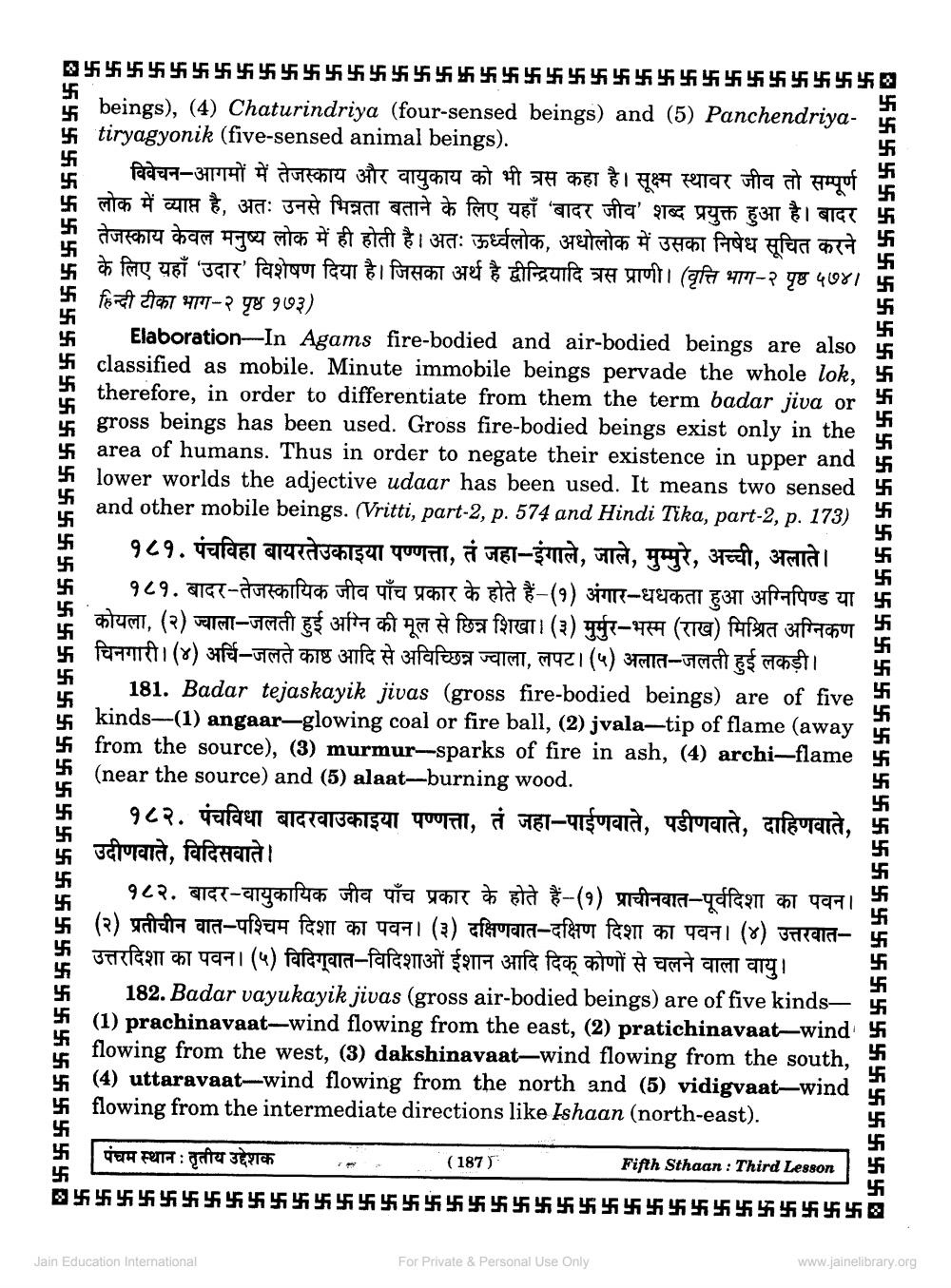________________
4听听听听听听听听听听听听听听听F FF 听听听听听听听听听听听听听听听听听听听听听听听听听听听听听听听
beings), (4) Chaturindriya (four-sensed beings) and (5) Panchendriya4i tiryagyonik (five-sensed animal beings).
विवेचन-आगमों में तेजस्काय और वायुकाय को भी त्रस कहा है। सूक्ष्म स्थावर जीव तो सम्पूर्ण म लोक में व्याप्त है, अतः उनसे भिन्नता बताने के लिए यहाँ 'बादर जीव' शब्द प्रयुक्त हुआ है। बादर ॥ + तेजस्काय केवल मनुष्य लोक में ही होती है। अतः ऊर्ध्वलोक, अधोलोक में उसका निषेध सूचित करने
के लिए यहाँ 'उदार' विशेषण दिया है। जिसका अर्थ है द्वीन्द्रियादि त्रस प्राणी। (वृत्ति भाग-२ पृष्ठ ५७४। म हिन्दी टीका भाग-२ पृष्ठ १७३)
Elaboration-In Agams fire-bodied and air-bodied beings are also classified as mobile. Minute immobile beings pervade the whole lok, 5 therefore, in order to differentiate from them the term badar jiva or
gross beings has been used. Gross fire-bodied beings exist only in the area of humans. Thus in order to negate their existence in upper and lower worlds the adjective udaar has been used. It means two sensed and other mobile beings. (Vritti, part-2, p. 574 and Hindi Tika, part-2, p. 173)
१८१. पंचविहा बायरतेउकाइया पण्णत्ता, तं जहा-इंगाले, जाले, मुम्मुरे, अच्ची, अलाते। ॐ १८१. बादर-तेजस्कायिक जीव पाँच प्रकार के होते हैं-(१) अंगार-धधकता हुआ अग्निपिण्ड या .
कोयला, (२) ज्वाला-जलती हुई अग्नि की मूल से छिन्न शिखा। (३) मुर्मुर-भस्म (राख) मिश्रित अग्निकण क ॐ चिनगारी। (४) अर्चि-जलते काष्ठ आदि से अविच्छिन्न ज्वाला, लपट। (५) अलात-जलती हुई लकड़ी।
181. Badar tejaskayik jivas (gross fire-bodied beings) are of five kinds-(1) angaar-glowing coal or fire ball, (2) jvala-tip of flame (away 卐 from the source), (3) murmur-sparks of fire in ash, (4) archi-flame (near the source) and (5) alaat-burning wood.
१८२. पंचविधा बादरवाउकाइया पण्णत्ता, तं जहा-पाईणवाते, पडीणवाते, दाहिणवाते, उदीणवाते, विदिसवाते।
१८२. बादर-वायुकायिक जीव पाँच प्रकार के होते हैं-(१) प्राचीनवात-पूर्वदिशा का पवन। (२) प्रतीचीन वात-पश्चिम दिशा का पवन। (३) दक्षिणवात-दक्षिण दिशा का पवन। (४) उत्तरवातउत्तरदिशा का पवन। (५) विदिग्वात-विदिशाओं ईशान आदि दिक् कोणों से चलने वाला वायु।
182. Badar vayukayik jivas (gross air-bodied beings) are of five kinds— (1) prachinavaat-wind flowing from the east, (2) pratichinavaat-windi flowing from the west, (3) dakshinavaat-wind flowing from the south, (4) uttaravaat-wind flowing from the north and (5) vidigvaat-wind flowing from the intermediate directions like Ishaan (north-east).
B))))))))))))))))55555555555555555555555555553
| पंचम स्थान : तृतीय उद्देशक
(187)
Fifth Sthaan : Third Lesson
For Private & Personal Use Only
www.jainelibrary.org
Jain Education International




